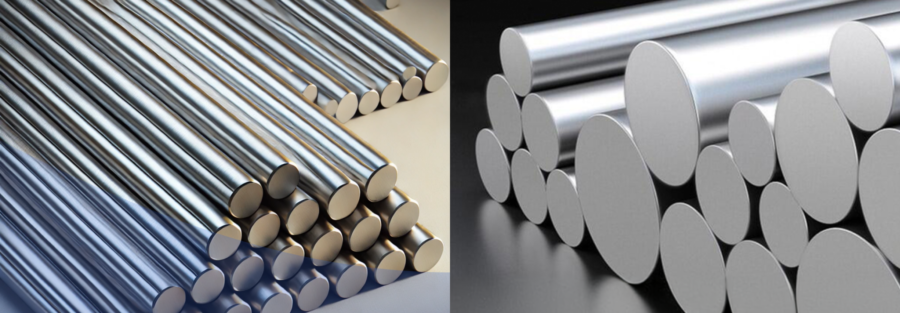Table of Contents
1. Introduction
When selecting the right stainless steel for your application, it’s important to understand the key differences between the various grades. 304 and 321 stainless steel are two of the most commonly used alloys, each offering unique advantages depending on the environment and application.
In this blog, we’ll break down the 304 vs 321 stainless steel debate, exploring the key differences, chemical compositions, applications, and more to help you make an informed decision for your industrial needs.
2. What is Stainless Steel 304?
SS 304 is the most widely used austenitic stainless steel alloy due to its excellent corrosion resistance and versatility. It contains 18% chromium and 8% nickel, offering strong protection against oxidation and corrosion in a variety of environments. SS 304 is often used in food processing, kitchen equipment, and chemical industries because of its ability to withstand a wide range of conditions.
In simple terms, SS 304 is a go-to material for general-purpose applications where corrosion resistance is required, but extreme heat resistance isn’t a major concern.
3. What is Stainless Steel 321?
SS 321 is a titanium-stabilized austenitic stainless steel, offering exceptional high-temperature performance and corrosion resistance. It contains titanium to prevent carbide precipitation during welding, which makes it ideal for welding applications. SS 321 also has a high nickel content, offering better heat resistance compared to SS 304, and is commonly used in aerospace, petrochemical, and high-heat environments.
In simple terms, SS 321 is a high-temperature resistant material, ideal for environments exposed to elevated temperatures and corrosive conditions.
4. Stainless Steel 304 vs 321: Key Differences
|
Property |
SS 304 |
SS 321 |
|
Chromium Content |
18-20% |
17-19% |
|
Nickel Content |
8-10% |
9-12% |
|
Titanium Stabilization |
No |
Yes |
|
Heat Resistance |
Moderate (up to 870°C) |
Excellent (up to 870°C continuous, 925°C intermittent) |
|
Corrosion Resistance |
Good |
Excellent in high-temperature, oxidative environments |
|
Weldability |
Good |
Excellent due to titanium stabilization |
|
Best Applications |
General-purpose use, food, beverage, and chemical industries |
High-temperature environments, aerospace, petrochemical |
5. Stainless Steel 321 Chemical Composition
|
Element |
Percentage (%) |
|
Chromium (Cr) |
17.0 – 19.0 |
|
Nickel (Ni) |
9.0 – 12.0 |
|
Titanium (Ti) |
≥ 0.70 |
|
Carbon (C) |
≤ 0.08 |
|
Manganese (Mn) |
≤ 2.0 |
|
Silicon (Si) |
≤ 1.0 |
|
Phosphorus (P) |
≤ 0.045 |
|
Sulfur (S) |
≤ 0.03 |
|
Iron (Fe) |
Balance |
Why This Matters:
- Titanium prevents carbide precipitation, allowing SS 321 to maintain its corrosion resistance and strength in high-heat environments.
- Chromium and nickel contribute to SS 321’s overall durability and resistance to oxidation.
6. SS 321 Pipe Applications
SS 321 pipes are used in high-heat environments where corrosion resistance and strength are needed. Common applications include:
- Heat exchangers
- Boiler tubes
- Furnace parts
- Petrochemical processing
- Aerospace components
SS 321 is particularly useful in environments where high temperatures and corrosive substances are present, making it ideal for industrial piping systems and high-pressure operations.
7. SS 304 vs SS 321: Equivalent Materials
Both SS 304 and SS 321 are part of the austenitic stainless steel family, but SS 321 offers enhanced resistance to high temperatures. When comparing the two, you may come across the following equivalent materials:
SS 304 Equivalent:
- 304L Stainless Steel: Low-carbon version of SS 304, often used in welding applications.
- 316 Stainless Steel: Offers better corrosion resistance due to the addition of molybdenum, ideal for chloride-exposed environments.
SS 321 Equivalent:
- 347 Stainless Steel: A titanium-stabilized alloy like SS 321 but with added niobium for better weldability in high-temperature applications.
- 304H Stainless Steel: A higher-carbon version of SS 304 that offers better heat resistance but lacks SS 321’s titanium stabilization.
8. FAQs
SS 321 is stabilized with titanium, which makes it more resistant to high-temperature oxidation and corrosion, especially in welding applications.
No, SS 321 offers excellent high-temperature resistance, but for chloride-rich environments like seawater, SS 316 is more suitable due to its better pitting resistance.
Yes, SS 321 is typically more expensive than SS 304 due to the added titanium and its specialized properties for high-temperature applications.
Yes, SS 321 has excellent weldability due to the titanium stabilization, making it ideal for welding in high-temperature environments.

